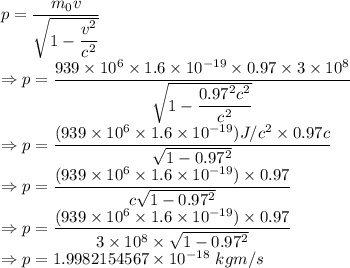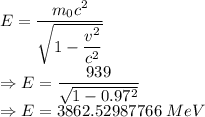
Physics, 12.02.2020 04:39, RaquelLWhite
A gold nucleus (with a radius of 6.5 fm in its rest system, containing 197 protons and neutrons of rest mass 939 MeV/c2 each) is accelerated to a speed of 0.97 c. Calculate (a) the momentum of an individual nucleon (ignoring binding energy effects). (b) the total energy of the gold nucleus, including its binding energy of 7.9 MeV per nucleon. (c) the diameter of the gold nucleus in the direction of motion as seen by an observer at rest.

Answers: 3
Other questions on the subject: Physics


Physics, 22.06.2019 14:20, timothyashburn8
Antireflective coatings on solar cells are often made by applying a thin film of silicon nitride (sinx), which has an index of refractive of 1.2, on the top of the silicon solar cell, which has a refractive index of about 3.5. however, the sun emits radiation of various wavelengths which the solar cell absorbs, and the antireflective coating can only absolutely minimize the reflection of one of these wavelengths. the coating thickness is chosen to reduce the reflection of green/yellow light (e = 2.2 ev), which is the most intense color in the solar spectrum (shown below). which of the following coatings would minimize reflection of green/yellow light? the answer is 820 nm how? what is the angular width of the central maximum of an electron traveling at 2 x 108 m/s going through a single slit of width 1 mm.
Answers: 1

Physics, 22.06.2019 18:30, lilypup004
Asled is being held at rest on a slope that makes an angle θ with the horizontal. after the sled is released, it slidesa distance d1 down the slope and then covers the distance d2 alongthe horizontal terrain before stopping. find the coefficient ofkinetic friction μk between the sled and the ground, assumingthat it is constant throughout the trip. find the coefficient of kinetic frictionμk. express your answer in terms of someor all of the variables d1, d2, and θ.
Answers: 1

Physics, 22.06.2019 19:30, beth999
Select light for the type of wave, adjust the wavelength so that the light is red, and increase the amplitude of the light to the max. then, select the start button at the source location to begin producing the waves. light is a form of electromagnetic wave, containing oscillating electric and magnetic fields. the wave amplitude detector mentioned above shows how the electric field oscillates in time at the location of the probe. the amplitude of the wave at the location of the probe is equal to the maximum electric field measured. how does the amplitude of the wave depend on the distance from the source?
Answers: 2
Do you know the correct answer?
A gold nucleus (with a radius of 6.5 fm in its rest system, containing 197 protons and neutrons of r...
Questions in other subjects:

Geography, 29.01.2020 22:42

Physics, 29.01.2020 22:42







Social Studies, 29.01.2020 22:43

Geography, 29.01.2020 22:43














